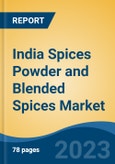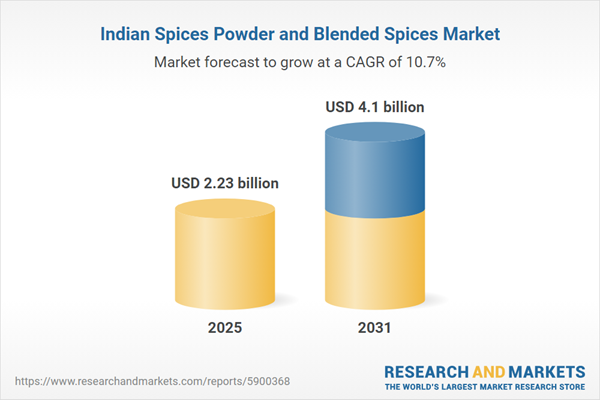Speak directly to the analyst to clarify any post sales queries you may have.
10% Free customizationThis report comes with 10% free customization, enabling you to add data that meets your specific business needs.
Key Market Drivers
Rising Consumer Preference for Convenience and Ready-to-Use Products
The increasing preference for convenience in meal preparation is a key driver of growth in the India spices powder and blended spices market. As urbanization accelerates and time constraints intensify, particularly among nuclear families and working professionals, consumers are turning toward pre-mixed spice blends that offer authentic taste without the need for manual mixing.These products simplify cooking processes, reduce preparation time, and provide consistency in flavor. Spice blends like garam masala, pav bhaji masala, and curry powders have become essentials in urban and semi-urban households alike. Moreover, the rise in demand for hygienically packed, branded products has accelerated the shift from loose spices to packaged alternatives. Even consumers in tier 2 and 3 cities are increasingly opting for ready-to-use spice blends due to better accessibility and growing awareness of product safety and quality.
Key Market Challenges
Quality Control and Standardization Issues
Maintaining uniform quality and standardization remains a major challenge in the India spices powder and blended spices market. Variations in soil, climate, and farming practices across regions result in inconsistent raw materials. Additionally, inadequate post-harvest handling, lack of advanced drying or storage infrastructure, and limited technological intervention among small-scale suppliers contribute to issues like contamination or adulteration.The fragmented nature of the market, with a substantial unorganized segment, complicates quality assurance. Despite the presence of certifications such as AGMARK and ISO, enforcement is inconsistent across local suppliers and small producers. Adulteration and substandard substitutes can diminish consumer trust and affect brand reputation, particularly in export markets where compliance with international safety and purity standards is mandatory. Ensuring traceability and consistent quality across the entire value chain remains a critical concern for industry stakeholders.
Key Market Trends
Increasing Demand for Organic and Natural Spices
The growing health consciousness among Indian consumers has led to rising demand for organic and naturally sourced spices. India’s significant footprint in the global organic farming sector - with 9.12 million acres dedicated to organic agriculture and 30% of the world’s organic producers - supports this shift. Consumers are increasingly seeking products free from synthetic fertilizers and chemical pesticides, perceiving organic spices as safer and more wholesome.Urban millennials and health-conscious households are particularly driving this trend, willing to pay a premium for products with verified sourcing and quality certifications. This has encouraged brands to expand their organic offerings and adopt transparent sourcing practices. Government initiatives promoting organic agriculture and incentives for exports further reinforce the trend. The move toward organic and natural spice products is shaping product development, branding, and market strategies, aligning with broader shifts toward sustainability and wellness in the food sector.
Key Market Players
- Aachi Masala Foods (P) Ltd
- Ds Spiceco Pvt Ltd
- Everest Food Products Pvt Ltd
- Dabur India Limited
- Patanjali Ayurved Limited
- Mahashian Di Hatti Pvt. Ltd.
- MTR Foods Private Limited
- Asquare Food & Beverages Pvt Ltd
- Ramdev Foods Products Private Limited
- Vasant Masala Private Limited
Report Scope:
In this report, the India Spices Powder and Blended Spices Market has been segmented into the following categories, in addition to the industry trends which have also been detailed below:India Spices Powder and Blended Spices Market, By Product Type:
- Spices Powder
- Blended Spices
India Spices Powder and Blended Spices Market, By End Use:
- Residential
- Commercial
India Spices Powder and Blended Spices Market, By Distribution Channel:
- Supermarkets/Hypermarkets
- Convenience Stores
- Online
- Others
India Spices Powder and Blended Spices Market, By Region:
- North
- South
- East
- West
Competitive Landscape
Company Profiles: Detailed analysis of the major companies present in the India Spices Powder and Blended Spices Market.Available Customizations:
With the given market data, the publisher offers customizations according to a company's specific needs. The following customization options are available for the report.Company Information
- Detailed analysis and profiling of additional market players (up to five).
This product will be delivered within 1-3 business days.
Table of Contents
Companies Mentioned
- Aachi Masala Foods (P) Ltd
- Ds Spiceco Pvt Ltd
- Everest Food Products Pvt Ltd
- Dabur India Limited
- Patanjali Ayurved Limited
- Mahashian Di Hatti Pvt. Ltd.
- MTR Foods Private Limited
- Asquare Food & Beverages Pvt Ltd
- Ramdev Foods Products private Limited
- Vasant Masala Private Limited
Table Information
| Report Attribute | Details |
|---|---|
| No. of Pages | 83 |
| Published | July 2025 |
| Forecast Period | 2025 - 2031 |
| Estimated Market Value ( USD | $ 2.23 billion |
| Forecasted Market Value ( USD | $ 4.1 Billion |
| Compound Annual Growth Rate | 10.6% |
| Regions Covered | India |
| No. of Companies Mentioned | 10 |









